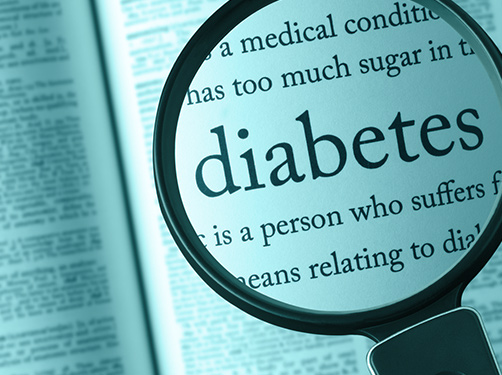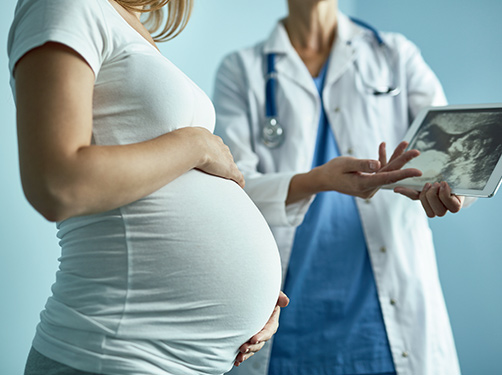How is gestational diabetes diagnosed?
Scientific support: PD Dr. Sandra Hummel
Gestational diabetes usually does not cause typical symptoms. This is why pregnant women should be tested for gestational diabetes in pregnancy weeks 24 to 28 as a precaution. This involves a glucose challenge test (oral glucose tolerance test). The pregnant woman drinks a glucose solution. Her blood glucose is then tested and if the value exceeds a certain limit, this may be a sign of gestational diabetes.
Women at increased risk of diabetes are tested for gestational diabetes in the first term of pregnancy. This concerns, for instance, overweight or older women. If their blood glucose is not elevated, another glucose test is carried out in the 24th to 28th week of pregnancy.

The glucose challenge test to diagnose gestational diabetes
In the week 24 to 28 of pregnancy, pregnant women are routinely tested for gestational diabetes. This is commonly referred to as the glucose challenge test. Experts refer to this as the oral glucose tolerance test (OGTT).
This involves drinking a glucose solution. Shortly after, the blood glucose value is tested. The value shows how well the body can process the amount of sugar. Generally this is a 2-stage procedure with no risk to the baby.
Pretest with 50 grams of glucose
First every pregnant woman is offered a pretest. She drinks a glass of water containing 50 grams of glucose (sugar). She does not need to have fasted for this. After an hour, blood is collected from a vein in the arm and the blood glucose test is determined. If the blood glucose value is normal, the test is ended. If at this point a blood glucose value of 135 mg/dl (7.5 mmol/l) or more is measured, another glucose test is carried out: The large glucose tolerance test with 75 grams of glucose. The result of the pretest in itself is not a diagnosis.
Diagnostic test with 75 grams of glucose
The pregnant woman must have fasted for the diagnostic or large glucose tolerance test. She cannot eat anything for at least 8 hours beforehand and nor have any drinks containing sugar. First the pregnant woman has a blood test, and then she drinks a sugar solution containing 75 grams of glucose. Then she has two blood tests: one after 1 hour and one after 2 hours after drinking the sugar solution.
Gestational diabetes is diagnosed when one of the 3 blood sugar levels is reached or exceeded:
- Fasting: 92 mg/dl (5.1 mmol/l)
- After 1 hour: 180 mg/dl (10.0 mmol/l)
- After 2 hours: 153 mg/dl (8.5 mmol/l)
If the fasting blood glucose value is 126 mg/dl (7.0 mmol/l) or blood glucose is 200 mg/dl (11.1 mmol/l) after 2 hours, it is not called gestational diabetes. The woman then has newly developed diabetes during her pregnancy. In this case, further tests are carried out to determine the form of the diabetes and to initiate a tailored treatment. She may have, for instance, type 2, type 1 or MODY diabetes.
If gestational diabetes has been diagnosed, metabolic control must be performed. Usually it is only necessary to change diet.
Click here for more information on the treatment of gestational diabetes.
Is the glucose tolerance test covered by the health insurance?
Usually the pretest with 50 grams of glucose is covered by the german health insurance. If this test value is over 135 mg/dl (7.5 mmol/l), the subsequent diagnostic test with 75 grams of glucose is covered by the health insurance.
How are women at increased risk of diabetes tested?
The doctor explores whether there is an increased risk of diabetes in a meeting when the pregnancy is confirmed. This may, for example, be the case if the woman is heavily overweight, is of advanced age when the pregnancy starts or had gestational diabetes in a previous pregnancy.
If there is an increased risk, a blood glucose test should be carried out in the 1st term of pregnancy, so right at the start of the pregnancy. Here, after fasting – she may not eat anything for at least 8 hours beforehand or have drunk anything containing sugar – blood is collected from the arm vein of the pregnant woman to determine the blood glucose value.
If the fasting blood glucose is over 92 mg/dl (5.1 mmol/l), a second measurement should be taken the following day. If the result is between 92 mg/dl (5.1 mmol/l) and 125 mg/dl (6.9 mmol/l), the diagnosis of gestational diabetes is confirmed. If the value is below this, another glucose test (glucose tolerance test) is carried out between the 24th and 28th week of pregnancy.
If the values are 126 mg/dl (7.0 mmol/l) or higher, the woman had diabetes before becoming pregnant.
Alternatively, the long-term glucose value (HbA1c value) can be measured. This value shows if blood glucose has been too high in the last 6 to 8 weeks. This is known as the long-term blood sugar memory. In healthy people whose glucose metabolism is intact, it is about 5 percent (31 mmol/mol).
If a value of up to 5.8 percent (40 mmol/mol) is reached, the blood glucose is taken again the following day after fasting, to rule out gestational diabetes. If the result is between 92 mg/dl (5.1 mmol/l) and 125 mg/dl (6.9 mmol/l), the diagnosis of gestational diabetes is confirmed.
If the HbA1c values are between 5.9 and 6.4 percent (41 and 46.5 mmol/mol) the diagnostic test is carried out with 75 grams of glucose to confirm or reject suspected gestational diabetes.
If the HbA1c value is over 6.4 percent (46.5 mmol/mol) the woman had diabetes before becoming pregnant.
Click here for more information on the risk factors of gestational diabetes.
Further information on gestational diabetes
Sources:
Deutsche Diabetes Gesellschaft et al.: S3-Leilinie Gestationsdiabetes mellitus (GDM) - Diagnostik, Therapie und Nachsorge. Langfassung. 2. Auflage. 2018
Deutsche Diabetes Gesellschaft et al.: S3-Leilinie Gestationsdiabetes mellitus (GDM) - Diagnostik, Therapie und Nachsorge. Patientinnenfempfehlung. 2. Auflage. 2018
Gemeinsamer Bundesausschuss: Patienteninformation. Ich bin schwanger. Warum wird allen Frauen ein Test auf Schwangerschaftsdiabetes angeboten? 2012
As of: 14.12.2022






